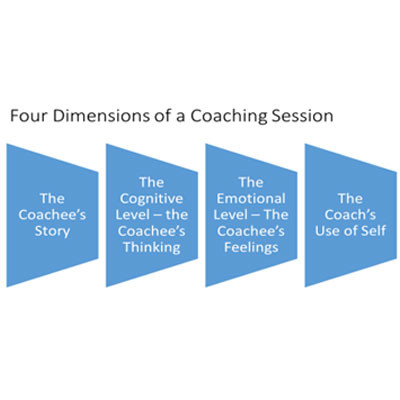Use of self is literally when the coach is a tool themselves within a coaching session – they are the instrument of change and it is a key part of developing a coach’s psychological mindedness and a way to advance coaching skill to a more advanced practitioner level.It refers to the coach using their own experience of being with the coachee as ‘data’ and communicating this to deepen the coachee’s awareness.
Benefits of Use of Self:
1. Enables a coach to collect rich experiential data in the “here and now” of the session. The relationship between coach and coachee is a microcosm of the real world outside the coaching room.
2. Your reaction as coach to the coachee, may reveal something hidden from the coachee that may be useful for the coachee to have feedback on, in a safe and supportive environment e.g. a coachee who goes into enormous detail on most stories in each session that leaves you bored, is likely to be doing the same thing with others in the work environment and your reaction may be typical of how others perceive them.
However, there are a number of conflicting issues for the coach on use of self:
1. As a coach you need to be tuned into your own reactions to a coachee and be able to decipher whether what you are feeling with them specifically is “normal” for you or something that is arising from being with them e.g. you may start a session feeling at ease and grounded then find within 20 minutes you are experiencing things such as boredom, frustration, disengagement.
2. The impact that a coachee has on you is essential information but do you share it with them and when and for what purpose?
3. How easy is it to attend to your coachee’s story as well as helicopter above yourself to notice your coachee’s style of relation and also your own reaction to it?
4. Use of self may feel risky. The coach may lose concentration on some of the words/story in exchange for observations about how a coachee interacts in the here and now.
5. Attending to our bodily sensations as well as emotional and mental reactions to a coachee can be quite a juggle, with some coaches having a strong preference in one area than another.
6. Knowing whether your reactions are just your own personal material
(They say more about your own unresolved issues than the coachee’s) e.g. a hard driving successful executive coachee may remind you of your father who you never felt able to challenge and this is evoked for you by the coachee sometimes without your awareness.
From Peter Bluckert “Psychological Dimensions of Executive Coaching” 2006:“There is also a question of how open clients are to hearing what you might have to say. They may be stuck in broadcast mode rather than receive mode. Consideration for where the client is right now becomes an obvious criterion for, if and when to use self. Beyond that you need to be able to clearly articulate your observations in a non-critical, supportive manner and without too much investment in where they are right. Sometimes the observation will hit the mark and your client will immediately recognise value and learning in what is being offered. On other occasions, clients may look a little bewildered – the offering doesn’t make a great deal of sense to them. In this case you need to leave it and back off gracefully…………...if the observation is made with a good heart and from considered thought then it is likely to be well received.”
What does this “Use of Self” look like in action?
It may be direct feedback from the coach to the coachee such as:
“I’ve noticed you give me a lot of detail and I’m finding that difficult to assimilate and keep up with. I wonder if you also do this with your team and co-workers. How might they react to that?”
Or a more reflective sharing of your own emotions:
- Feelings (“I notice a deep sense of sadness in me as you said that; do you think there is sadness around?”)
- Bodily experiences (“as we are talking I notice a real heaviness in my body; I’m wondering if that says something about what is happening right now”)
- Images that come to mind (“as we are talking an image of a treadmill comes to mind; does that catch a sense of what it’s like for you”)
Personal Development on Use of Self
In order to work at this level, coaches need to invest in their own personal development so they are able to examine their own thoughts, feelings, drives, hot buttons and habitual behaviours/triggers. This can be through counselling, therapy, coaching and supervision and is a lifelong journey.
"Until you make the unconscious conscious, it will direct your life and you will call it fate"
(Carl Jung)


